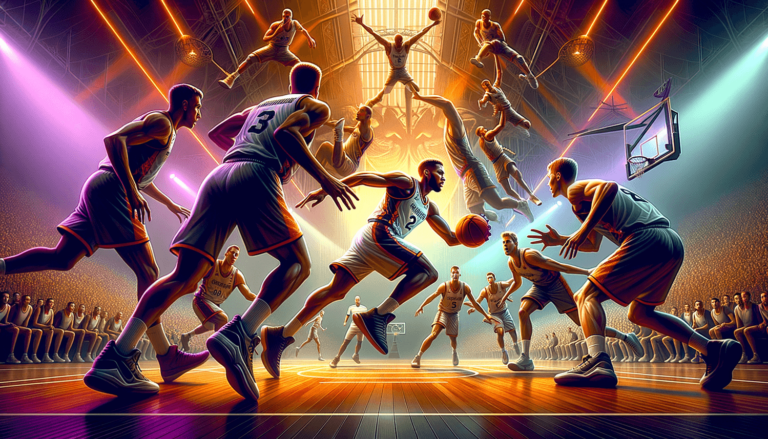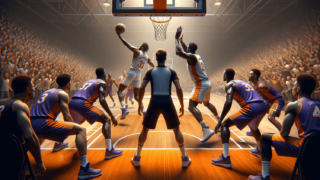
Personal Foul Limit Rule in Basketball
Written by: Basketball Universe
Last updated:

Slam dunk your understanding of the game with this in-depth look at the Personal Foul Limit Rule in Basketball! 🏀 As both a fun and professional guide, we’ll break down the intricacies of this critical aspect of the game. From understanding its importance in maintaining fair play to exploring different leagues’ regulations, the target reader will be well on their way to mastering this rule like a pro. So, let’s lace up our basketball knowledge and delve into the nitty-gritty of the Personal Foul Limit Rule, as we showcase why this rule is a powerful game-changer in the world of basketball.
Personal Foul Limit Rule in Basketball
The Personal Foul Limit Rule in basketball sets a maximum number of personal fouls a player can commit before facing disqualification from the game. The purpose of this rule is to maintain fair play and sportsmanship among players while preventing excessive roughness or aggressive behavior on the court. The exact number of fouls allowed before disqualification depends on the specific league, with common limits being 5 fouls in high school and college games and 6 fouls in the NBA.
Understanding Personal Fouls
Before diving into the Personal Foul Limit Rule, it’s essential to understand what constitutes a personal foul in the game of basketball. Personal fouls occur when a player breaks one of the basketball rules by engaging in illegal physical contact, such as holding, pushing, or tripping an opponent. This contact can happen on offense or defense and is generally called when it negatively impacts the opponent’s movements or offers an unfair advantage on the court.
Foul Limit Variations: A League-by-League Comparison
While the concept of the Personal Foul Limit Rule is universal, the specific limits players are allowed before facing disqualification vary by league. Here’s a breakdown of some common foul limits in different basketball organizations:
National Basketball Association (NBA)
In the NBA, players are allowed a maximum of 6 personal fouls before disqualifying themselves from the game. Any player committing their sixth personal foul must leave the game and cannot return. In overtime periods, the allowed foul limits do not reset; however, players receive one additional personal foul if the game enters its second overtime.
International Basketball Federation (FIBA)
As the governing body for international basketball competitions, FIBA allows each player to commit up to 5 personal fouls in a single game. Once a player registers their fifth foul, they must leave the game and remain on the bench for the remainder of the match. Like in the NBA, foul limits do not reset during overtime, and players retain their foul count from the regulation time.
National Collegiate Athletic Association (NCAA)
In the NCAA, the personal foul limit for players is set at 5, similar to FIBA. College basketball players who reach this limit are disqualified from the game and must remain on the bench. Foul limits don’t reset during overtime periods in NCAA games as well.
High School Basketball
High school basketball may have some state-by-state variations, but most follow the National Federation of State High School Associations (NFHS) rulebook, which allows players to commit up to 5 personal fouls before they face disqualification. Like in other leagues, overtime does not reset foul limits for players, and they will keep the foul count from the regulation time.
Team Fouls and Their Impact on Gameplay
In addition to individual players’ personal foul limits, it’s essential to understand how these fouls accumulate throughout a game, contributing to “team fouls.” A team’s foul count plays a significant role in the strategies both coaches and players can employ during a match.
Team Foul Summary and Penalty Situations
Team fouls occur when a team accumulates a certain number of personal fouls throughout a game. These fouls generally result in penalty situations, such as bonus free throws or technical fouls, which impact how the game is played. When a team reaches the required foul limit, each subsequent personal foul committed results in free throws for the opposing team, even if the fouled player was not in the act of shooting.
Strategic Implications of Fouling Out
Players in foul trouble must adjust their style of play to avoid disqualification, often necessitating a more conservative approach on defense. This situation can create opportunities on the court for the opposing team. A team might purposefully attempt to exploit this weakness and target the disadvantaged player directly, hoping to force them out of the game or score points from foul shots. Coaches may also have to rotate their players and change lineups to keep their players’ foul situations under control.
Technical and Flagrant Fouls: Beyond the Personal Foul Limit
Apart from personal fouls, players can also accumulate technical or flagrant fouls throughout a game. These fouls differ in nature from personal fouls and have different implications concerning disqualification.
Technical Fouls
Technical fouls stem from unsportsmanlike conduct, such as disputing an official’s call, taunting, or engaging in any behavior that violates the spirit of the game. These fouls are assessed by referees, and a player with multiple technical fouls may face ejection from the game. Keep in mind that technical fouls, unlike personal fouls, do not contribute to a player’s personal foul limit. However, these fouls are included in the team’s foul count, which can impact gameplay.
Flagrant Fouls
Flagrant fouls are severe infractions that involve excessive or violent contact with an opponent. These fouls are divided into two categories: flagrant foul 1 and flagrant foul 2. Flagrant foul 1 is called for unnecessary contact during gameplay, while flagrant foul 2 involves contact that is both unnecessary and excessive. While the punishment varies depending on league-specific regulations, players may be disqualified from the game for accumulating two flagrant fouls, regardless of their current personal foul count.
Fouls and Player Management: Coach’s Responsibility
A key component of managing a basketball team is navigating foul limits and their implications. Coaches play a significant role in helping their players avoid foul trouble and adjusting team dynamics when necessary.
Player Education and Awareness
Coaches should emphasize the importance of playing smart defense and avoiding unnecessary fouls to their players. Educating athletes on the rules of the game and the consequences of committing fouls can help improve their in-game decision-making and minimize foul troubles.
Managing Substitutions and Rotations
A good coach will use their knowledge of their players’ foul situation to make informed decisions about substitutions, managing player rotations to maximize team effectiveness while minimizing the risk of disqualifications. This ability to adapt on-the-fly helps ensure the team plays at its full potential despite foul limits dominating the game.
Personal Foul Limit Rule: Preserving Fairness in Basketball
An essential element of basketball rules is the Personal Foul Limit Rule, which helps maintain fair play and sportsmanship in the game. By understanding the nature of personal fouls, team fouls, and technical and flagrant fouls, basketball enthusiasts can better appreciate the complex strategies that coaches and players use throughout the competition. Armed with this knowledge, fans and aspiring players alike can further their enjoyment and understanding of the dynamic and exciting world of basketball.
Impact of Fouls on Game Tempo and Style
Fouls can significantly shape the tempo and style of a basketball game, forcing teams to alter their strategies depending on the foul situation. The accumulation of fouls by individual players and teams as a whole can lead to adjustments in defensive and offensive tactics. Coaches may need to instruct their players to avoid aggressive plays that have a higher risk of drawing fouls, such as driving to the basket or employing tight man-to-man defense.
Foul Prevention: Defensive Techniques and Tips
Mastering proper defensive techniques and body positioning can help players reduce their personal and team fouls. Here are some tips to avoid foul trouble while preventing easy scoring opportunities for the opposing team:
Maintain a Proper Stance
A low, wide stance with bent knees and hands up is essential for maintaining quick lateral motion and avoiding reaching for the ball. This stance allows players to stay in front of their opponents instead of falling behind, reducing the risk of fouling.
Anticipate Opponent’s Movements
By carefully observing their opponents, players can often anticipate the direction in which they’re moving, enabling them to position themselves better for a successful defensive stand without committing fouls.
Communicate with Teammates
Effective communication between players is not only crucial for successful team defense but also instrumental in reducing fouls. Alerting teammates to screen situations or calling out ongoing plays can prevent lapses in defensive coverage and minimize the need for players to cover large distances and risk fouling.
History of Personal Foul Limit Rule in Basketball
The Personal Foul Limit Rule has evolved over time, mirroring the sport’s growth itself. Upon basketball’s invention by Dr. James Naismith in 1891, there were no specific regulations concerning fouls. With no initial limits on fouls, the game often became overly physical and aggressive. As basketball progressed and leagues formalized their rulebooks, the Personal Foul Limit Rule emerged as an instrumental tool to create a more controlled and strategic game experience. Basketball aficionados can appreciate the sport’s transformation and the development of modern foul rules that promote fairness and sportsmanship in the global basketball community.
The Role of Referees in Enforcing Foul Rules
Referees play a critical role in ensuring that personal foul rules are adhered to, as they are responsible for calling fouls on players who commit infractions. While the process of officiating a game and monitoring fouls can be subjective, referees are trained to prioritize player safety and maintain the integrity of the game. Understanding the nuances of foul calling and its impact on the game’s outcome highlights the importance of refs in upholding the Personal Foul Limit Rule and other basketball regulations.
Frequently Asked Questions
For a quick overview of essential information related to the Personal Foul Limit Rule in Basketball, this FAQ section addresses some commonly asked questions. Explore these questions and answers to deepen your understanding of personal fouls and their impact on the game.
1. What is a personal foul?
A personal foul occurs when a player engages in illegal physical contact, such as holding, pushing, or tripping an opponent, which negatively impacts the opponent’s movements or provides an unfair advantage on the court.
2. How many fouls are allowed in the NBA before disqualification?
In the NBA, a player is disqualified and must leave the game after accumulating 6 personal fouls.
3. How many fouls are allowed in international play and college basketball?
International play governed by FIBA and college basketball regulated by the NCAA both set the personal foul limit at 5 before a player is disqualified.
4. Do technical and flagrant fouls count towards the personal foul limit?
No, technical and flagrant fouls do not directly count toward a player’s personal foul limit. However, they do contribute to a team’s foul count, which can affect gameplay and free throw opportunities.
5. What is the difference between a team foul and a personal foul?
A personal foul refers to illegal contact committed by an individual player, while a team foul is the total accumulation of personal fouls committed by a team during a specific period of play.
6. How do fouls impact gameplay strategies?
Fouls can influence gameplay strategies by forcing players to adjust their style of play to avoid trouble, causing coaches to change lineups, and creating scoring opportunities from foul shots for the opposing team.
7. How can players prevent committing personal fouls?
Players can prevent personal fouls by maintaining a proper defensive stance, anticipating opponents’ movements, communicating effectively with teammates, and employing smart decision-making on the court.
8. What are the consequences of reaching the personal foul limit?
When a player reaches the personal foul limit, they are disqualified from the game and must remain on the bench for the remainder of the match.
9. Are there any differences in team foul consequences between leagues?
Yes, there are slight variations in team foul consequences between leagues. Each league has specific provisions regarding the number of team fouls allowed before penalty situations, such as bonus free throws, are applied.
10. How has the Personal Foul Limit Rule evolved throughout the history of basketball?
Upon basketball’s invention, there were no specific foul limit rules. As the sport progressed and leagues established their rulebooks, restrictions on personal fouls emerged to create a more strategic game experience and promote sportsmanship.
Featured Posts
- No pillar pages found.





